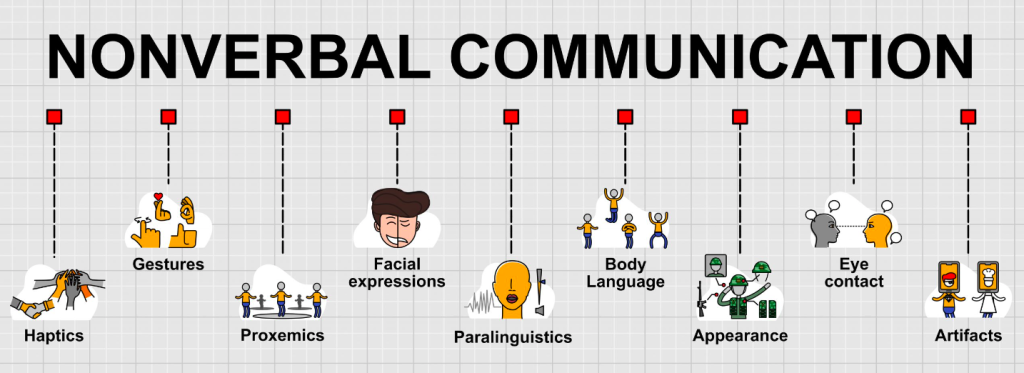Read People – Have you ever found yourself wishing you could delve into people’s innermost thoughts and truly comprehend their emotions? Mind-reading seems like a fantastical notion; mastering the art of nonverbal communication enables you to perceive and interpret what people are trying to convey. Astonishingly, studies have shown that a mere 7% of communication is accomplished through verbal exchanges, while nonverbal signals, such as body language, facial expressions, and tone of voice, make up a whopping 55%.
The ability to read people can be an invaluable asset in various areas of your life, from your relationships to your professional endeavors. This article will delve into the intricate craft of nonverbal communication and equip you with the practical tools necessary to read people competently.
Understanding Body Language
Body language is an essential aspect of nonverbal communication to read people. It refers to the physical movements and gestures that people make while communicating. Here are some examples of familiar body language cues and what they might mean:
- Crossing arms: this may indicate defensiveness, discomfort, or disinterest
- Leaning forward: this can show interest or engagement
- Avoiding eye contact: this may suggest deception or discomfort
- Nodding: this can indicate agreement or attentiveness
- Fidgeting: this may mean nervousness or discomfort
Body language offers many insights into a person’s innermost thoughts and emotions, as evidenced by the following examples. Nonetheless, it is vital to remember that body language can be nebulous and reliant on context. Thus, one must consider the entire situation’s milieu to decode and interpret body language cues correctly.
Interpreting Facial Expressions
Facial expressions are another crucial factor of nonverbal communication and to read people. They can provide information about a person’s emotions and thoughts. Here are some common facial expressions and what they might mean:
- Observe the face: Pay close attention to the person’s facial features, including the eyes, eyebrows, mouth, and overall muscle movements. Look for any changes or movements that might indicate an emotion or intention.
- Consider the context: Take into account the situation and the person’s surroundings. Contextual cues can help you understand the meaning behind their facial expression. For example, if someone is in a joyful setting, their smile is likely a sign of happiness rather than sadness.
- Look for clusters of cues: Instead of relying on a single facial movement, look for patterns and combinations of expressions. People often display multiple facial cues simultaneously, which can provide a more accurate interpretation. Consider the overall configuration of the face and how different facial muscles work together.
- Pay attention to timing and duration: Facial expressions can be fleeting or prolonged, and the timing can offer valuable insights. A quick, involuntary expression might reveal a person’s initial reaction before they consciously mask it. Conversely, a more sustained expression is likely to reflect their ongoing emotional state.
- Consider cultural and individual differences: Remember that cultural backgrounds and personal traits can influence the interpretation of facial expressions. Certain gestures or expressions may hold different meanings across cultures. Additionally, individuals may have unique facial expressions that deviate from general patterns, so try to understand the person’s baseline behavior before making judgments.
- Validate through communication: While facial expressions provide valuable information, it’s important to confirm your interpretations through verbal communication. Engage in active listening and ask open-ended questions to gain a better understanding of the person’s emotions or intentions.
- Practice empathy: Interpreting facial expressions requires empathy and sensitivity. Put yourself in the other person’s shoes and try to understand their perspective. Avoid making assumptions or jumping to conclusions based solely on facial cues.
Remember that interpreting facial expressions is not an exact science, and there can be variations in individual expressions and cultural norms. It takes practice and observation to become more skilled at reading facial cues accurately.
Paying Attention to Tone of Voice

The tone of voice can also provide valuable information about a person’s emotions and intentions. Here are some examples of different styles of voice and what they might mean:
- Soft and gentle: this can indicate calmness, kindness, or sympathy
- Loud and forceful: this may suggest anger or aggression
- Monotone: this can indicate boredom or lack of interest
- High-pitched: this may offer nervousness or excitement
Paying attention to tone of voice is essential, as it can often reveal more about a person’s emotions than their words alone.
Reading People in Different Situations
Reading people in different situations involves understanding and interpreting various non-verbal cues, such as body language, facial expressions, vocal tone, and overall behavior. Here are some tips to help you read people in different situations:
- Pay attention to body language: Observe a person’s body posture, gestures, and movements. Notice if they are standing or sitting upright with an open posture, indicating confidence and openness, or if they are slouched or have crossed arms, suggesting defensiveness or discomfort.
- Observe facial expressions: Facial expressions can provide valuable insights into a person’s emotions and reactions. Look for cues like raised eyebrows, squinted eyes, smiles, or frowns. Combine these cues with other non-verbal signals to get a more accurate understanding.
- Listen to vocal tone and speech patterns: Pay attention to the tone, pitch, and speed of someone’s voice. A person’s voice can convey emotions such as enthusiasm, frustration, or sadness. Additionally, note any changes in their speech patterns, such as hesitations or stammering, which might indicate nervousness or uncertainty.
- Notice eye contact: Eye contact can reveal a person’s level of interest, engagement, or confidence. Direct eye contact can indicate attentiveness and honesty, while avoiding eye contact may suggest discomfort, disinterest, or deception. However, cultural norms can influence eye contact, so be mindful of individual differences.
- Consider proxemics: Proxemics refers to the use of personal space. Notice how close or far someone stands or sits from others. Respect personal boundaries and adjust your own behavior accordingly. Invasion of personal space or extreme distance can indicate discomfort or a desire for privacy.
- Look for microexpressions: Microexpressions are brief and involuntary facial expressions that occur within a fraction of a second. They can reveal true emotions that someone may be trying to conceal. Train yourself to spot these fleeting expressions, such as a split-second flash of anger or surprise.
- Analyze behavioral patterns: Pay attention to consistent behavioral patterns and how they align with different situations. Does the person consistently exhibit confident body language, or do they display signs of nervousness or insecurity? Identifying consistent patterns can help you understand someone’s overall disposition.
- Consider cultural and situational factors: Cultural norms and situational contexts can greatly influence people’s behaviors and expressions. Different cultures may have varying expectations regarding eye contact, physical contact, and personal space. Take these factors into account to avoid misinterpretations.
- Practice active listening: Listening actively involves not only hearing the words someone says but also observing their non-verbal cues. Give your full attention, maintain eye contact, and show genuine interest in what the person is saying. This will help you pick up on subtle cues and understand their underlying message.
- Be empathetic and open-minded: Reading people effectively requires empathy and an open mind. Consider that everyone is unique, and their behaviors may be influenced by a variety of factors. Avoid jumping to conclusions and seek to understand the person’s perspective and emotions.
Reading people accurately is a skill that develops over time with practice and experience. It’s important to combine non-verbal cues with verbal communication and take into account individual differences and cultural contexts for a more comprehensive understanding of people in different situations.
Tips for Improving Your People-Reading Skills
Improving your people-reading skills takes time and practice. Here are some tips:
- Practice Active Listening: Active listening applies to paying close awareness to what the other person is saying and trying to understand their perspective. It can help you to pick up on subtle cues in their tone of voice and body language.
- Observe People in Different Situations: The more you observe people in different situations, the better you’ll become at reading them. Try to watch people in social situations, business meetings, or other situations where nonverbal communication is essential.
- Learn to Control Your Nonverbal Cues: Your nonverbal cues can affect how others perceive you. Learning to control your body language, facial expressions, and tone of voice can help you to communicate more effectively with others.
- Read Books on Body Language: Many books are available on body language and nonverbal communication. Reading these books can provide you with valuable insights and tips on how to read people effectively.
- Take Online Courses: There are numerous online studies available that can help you to improve your people-reading skills. These courses can provide practical tips and strategies for reading people in different situations.
Conclusion
Learning to read people is an essential skill that can assist you in many aspects of life. By delivering attention to body language, facial expressions, and tone of voice, you can gain valuable insights into a person’s thoughts and feelings. By practicing active listening, observing people in different situations, learning to control your nonverbal cues, reading books on body language, and taking online courses, you can improve your people reading skills and become a more effective communicator.
FAQs
- Can anyone learn how to read people?
Yes, anyone can learn how to read people with practice and dedication.
- What are some common mistakes people make when reading body language?
Some common mistakes people make when reading body language include misinterpreting cues, relying too heavily on a single cue, and failing to consider the context of the situation.
- Is it possible to fake body language cues?
Yes, it’s possible to fake body language cues. However, faking cues can be challenging, and most people are not very good at it.
- How can I improve my nonverbal communication skills?
To improve your nonverbal communication skills, you can practice active listening, observe people in different situations, learn to control your own nonverbal cues, read books on body language, and take online courses.
- How important is nonverbal communication in business settings?
Nonverbal communication is essential in business settings, as it can provide valuable insights into a person’s thoughts and intentions. Understanding nonverbal cues can help you to negotiate effectively, build strong relationships with clients and colleagues, and succeed in your career.
